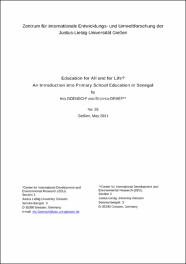| dc.description.abstract | Generally, school participation in Senegal has achieved a lot of progress in recent years. However, several problems remain to be tackled for further improvement. Still, too many children never attend a school. An even more severe problem is the high rate of drop outs, especially when it comes to the transition from primary to secondary school. Here, the national grade six exam, higher costs of schooling and still limited availability of secondary schools are the main barriers. As a result, only a fraction of children completes the ten years of compulsory schooling which is considered necessary to have superior job perspectives. Another issue regarding absenteeism or incomplete formal schooling is the popularity of Quranic education in Senegal. Many parents prioritize religious (esp. Quranic) studies and do not want their children to attend a formal school. In many cases, those who try to combine formal and religious schooling sooner or later have to decide on whether to drop one or the other. Despite the existence of differences between rural and urban milieus no substantial gender disparity can be observed at the primary school level. At the secondary school level, however, girls education perspectives worsen so that completion of ten years of schooling is even less likely for girls than for boys.
While the quantity of enrolled children has undoubtedly risen during the past years, the development of school quality is more ambiguous. Many school buildings are in a bad condition and pedagogical material is often lacking or hardly usable. After the summer holidays many school facilities face damages due to heavy rainfalls which lead to delayed starts and many schools cannot afford the maintenance costs. The quality of classes itself suffers from too big class sizes, multigrade classes and irregular attendance of pupils.
In summary it can be stated that primary school education in Senegal has achieved some noticeable improvements. However, high drop out rates and rivalry with Quranic schooling lead to a low percentage of students with completed secondary education or higher. Since it is expected that formal schooling only pays off in economic terms after at least ten years of education, the achievement of a higher share of students with completed secondary school should be a reasonable task.
The purpose of further study will thus be to shed more light on some of the reasons preventing school enrollment and completion. One task will consist in identifying the reasons why many children are never enrolled in school. The research project will proceed with a household survey in the region of Saint-Louis. This region nearly reflects average educational figures of the whole country and is very diverse regarding geographical conditions, population density and economic activity of the population. Data from this survey will allow to disentangle the role of supply and demand sides. According to our expectations and impressions gained from the qualitative field work, even in areas where public schools are available and accessible, not all children are enrolled in school. For this group, parents might not see the benefit of attending formal school or might favor rival activities such as work or attendance of a religious school. A related question is whether school enrollment then depends primarily on household characteristics. Families of a certain educational level and of specific professions could be more prone to sending their children to school. On the other hand, there seems to be heterogeneity within households. We will have to study why some children attend school while their siblings do not. Reasons for the higher drop out rates of girls will also be subject to further study. | en |



